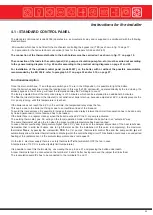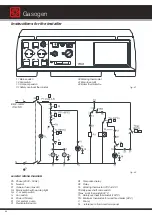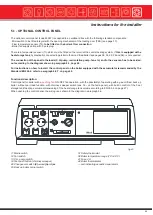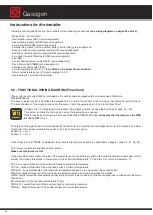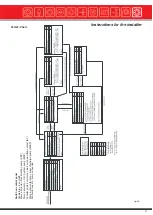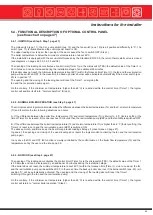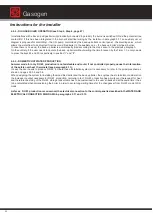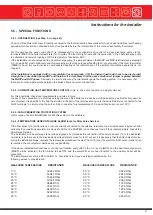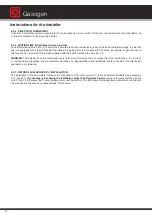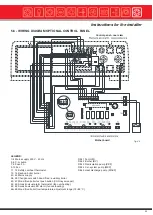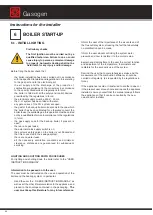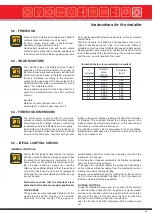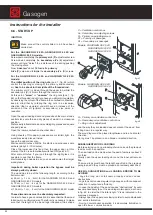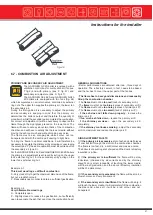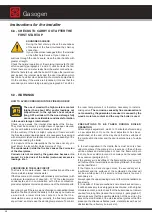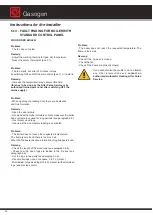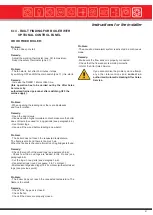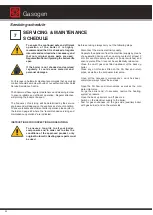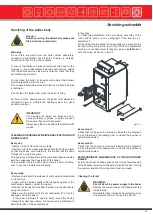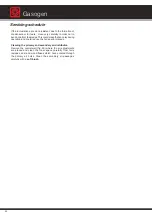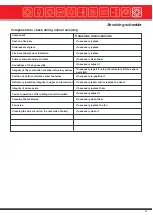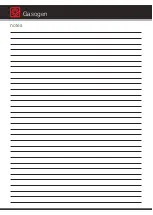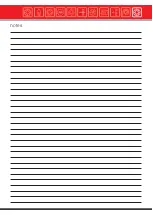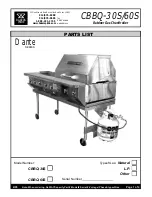
57
Instructions for the installer
fig. 49
6.7 - COMBUSTION AIR ADJUSTMENT
PRIMARY AND SECONDARY AIR ADJUSTMENT
The GASOGEN G3 2S boiler is equipped with a
ventilation control box for combustion air (fan pos.
7 fig.2) and with primary (pos. P, fig. 47) and
secondary air adjusters. (pos. S, fig. 47).
The GASOGEN G3 65 2S and GASOGEN G3 80
2S boilers are equipped with two fans (fig. 48)
which incorporates a non-return valve, controlled by external
ring nuts. The upper fan supplies the primary air, the lower fan
the secondary air.
During the first ignition it is necessary to adjust the primary
and secondary air, keeping in mind that the primar y air
determines the boiler’s output and therefore the quantity of
wood burnt, whilst the secondary air completes the combustion.
For correct air adjustment it will be necessary to observe the
flame through the sight glass placed on the lower door. The
flame will have to occupy about two thirds of the combustion
chamber, and will have to quietly lick the lower cradle, without
moving the ash too much and without making any noise.
The flame must be an orange-pink-white colour, not too
transparent and with the centre part veering to light blue.
To bring the flame to optimal conditions, it will therefore be
necessary to regulate the primary air by screwing or unscrewing
the screw (pos. P); the same operation must be carried out for
the secondary air (pos. S).
For the GASOGEN G3 65 2S and GASOGEN G3 80 2S boilers
the primary air adjustment is achieved by acting on the upper
fan’s external ring nut; for the secondary air by acting on the
lower fan’s external ring nut.
Example n.1
Thick, wet wood logs = difficult combustion
S - Very closed (try to get the maximum dimension of the flame,
but not a reddish colour).
P - Reasonably open in order to obtain a sufficient gasification.
Example n. 2
Very inflammable wood logs
S - Completely open.
P - Slightly closed to reduce the gasification, but sufficiently
open to evacuate the ash that can close the combustion head.
GENERAL SUGGESTIONS
- Better performances are obtained after two - three days of
operation. The refractory cement, in fact, needs to be baked
and the tar has to cover the upper part of the fire box.
-
The flame has to have good dimensions and reasonably
fill-up the combustion chamber.
- The
flame
must not be
too red
(lack of secondary air S).
- The
flame
must not be
too blue
(excess of secondary air S).
- The
flame
must not be
too noisy
(excess of primary air P).
- The
flame
must not be
too small
(lack of primary air P).
- If
the ash does not falls down properly
- increase the
primary air P.
- If
too much ash falls down -
reduce the primary air P.
- If
the chimney smokes -
open the secondary air S
completely.
- If
the chimney continues smoking
- adjust the secondary
air S to maximum and reduce the primary air. P.
AIR ADJUSTMENT FAULTS
1) If
the primary air is excessive
a lot of ash and small pieces
of coal will fall through the slot into the combustion chamber.
The flame is too fast, dry, a cold colour and makes a noise.
The boiler is consuming a lot of wood and the door’s refractory
insulation is white.
2) If
the primary air is insufficient
the flame will be slow,
indecisive, influenced by air currents and by the chimney
draught, very small, incapable of touching the lower cradle,
with low ash production and the door’s refractory insulation
will be of a dark colour.
3) If
the secondary air is excessive
the flame will be small, a
blueish colour and very transparent.
4) If
the secondary air is insufficient
the flame will be big, it
will touch the lower cradle, it will completely fill the combustion
chamber and, above all, it will be a red colour and not
transparent
Cut
Содержание Gasogen
Страница 1: ...Wood Fired Boiler Gasogen 29 93kW Installation and Servicing Manual ...
Страница 66: ...Gasogen notes ...
Страница 67: ...notes ...

